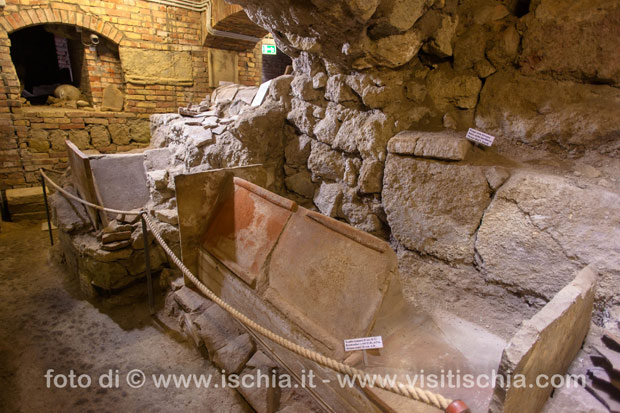Museum of the excavations of Santa Restituta

Ischia is a magical land where history, myth and nature intersect continuously until they merge. A privileged destination for nineteenth-century Grand Tour, that cannot be renounced for training program of every European traveller caught and that in all the lands of the Gulf of Naples could be reflected in the stories of the Greek and Latin classics. Not only myth, but also traditional and religious events such as those dedicated in May, to Santa Restituta, African martyr and patron saint of the island of Ischia.
And it is from the piety that comes to life a small archaeological gem worthy of careful attention to every visitor alive to the history and deepest identity of the places: the Museum of the ruins of Santa Restituta, an underground complex where the process of musealization occurred in the same places of the revival.
We are in the historical centre of the town of Lacco Ameno, whose physical configuration corresponds in principle to that one of the ancient Pithekoussai, Greek allocation dating back to the eighth century. B.C. of the urban setting well-defined: the necropolis in the Valley of San Montano, the acropolis of Monte Vico, the district metallurgical and manufacturing area of the excavations and the hill of Mezzavia, landing stores along the marina, which then enjoyed other spaces for bradyseism very different from those of today.
The excavations are born thanks to the passion and tenacity of Don Pietro Monti, rector of the church dedicated to the worship of Santa Restituta, but also that bit of luck that turns in their favour small coincidences of life. At the dawn of the '50s, when was decided to remove the tiles which, since 1711, formed the floor of the church, it was discovered another floor below in majolica tiles of 1470. It was not over: it continued digging and came upon a beaten earth floor, even below a Roman floor and three late Roman tombs in earth.
Since that time, the exploration of the soil no longer has ended.
The excavations have allowed the researchers to identify both a cemetery and an "industrial" area where there were ovens for baking the clay. The vases were in fact Pithecusan processed and cooked at that point, only to be sold and exported throughout the Mediterranean Sea.
You can then observe, among the many findings come to light, shards and fragments of amphorae for wine, coins minted around the fifth century. BC, a rich collection of amulets in the shape of beetles imported from Egyptian cult, fragments of statues or plates depicting divine figures such as, for example, the Head of the nymph Arethusa (IV century BC) and the Head of Demeter (also dating back to the IV century BC). The cult of Apollo is witnessed by a patera (dish) containing votive projecting the image of the god lying smooth, that of Eros statue that depicts him as a young, naked, with his bow and arrows, and wings vigorously. And yet a lekythos of clay and black paint, clay antefix in red paint or even arula of white marble polished chisel dating to the third century BC. Tangible signs of woven and laminated succession of cultures and civilizations of the past.
In a corner of the excavations of Santa Restituta was rebuilt the environment of a typical Pithecusan house. The weights of the frame, those that were tied to the ends of each group of warp threads, are original. In an urn are placed small clay toys (horses, donkeys, boats, dolls and birds) which entertained the children of the time. As rightly highlights the archaeologist Giorgio Buchner "Today the scientific purpose of the excavation is no longer to recover individual handsome objects but that one to know, through the media and other information gathered during the excavation, history of the populations of the past, understood not so much as the political history of kings and wars, but as knowledge of ways of life, the social structure of human settlements, trade indicated by the articles imported or exported for over regions, the mutual influences made between different civilizations".
One of the latest discoveries is the baptistery with a hall in the centre of the circular tank, "fenced with wall raised from the floor, covered with marble, with three steps to descend to be baptized by immersion. Conclusive evidence for the Christian complex, the largest island and the only ready to house - perhaps already in the mid-fifth century AD - the relics of Saint Restituta of Carthage.
by Gianluca Castagna
































